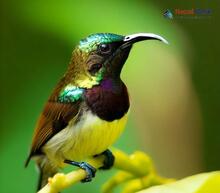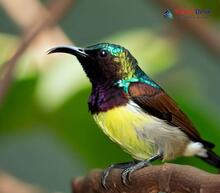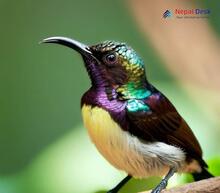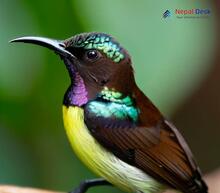The world of avian biodiversity is truly awe-inspiring, with countless bird species displaying a rich variety of colors, shapes, and behaviors. Among these countless species lies the fascinating genus Leptocoma, a group of small passerine birds belonging to the Nectariniidae family. In this article, we will delve into the intriguing evolutionary tree, morphology, and ecology of the Leptocoma genus, while also highlighting their existence in Nepal.
Evolutionary Tree: Tracing the Roots
The Leptocoma genus has its roots firmly planted in the broader Nectariniidae family of sunbirds. The family itself is thought to have originated in Asia within the last 15 million years. Leptocoma's distinct evolutionary tree comprises several species commonly known as sunbirds or spiderhunters. Some of these include the Copper-throated Sunbird (Leptocoma calcostetha) and Purple-throated Sunbird (Leptocoma sperata), showcasing a colorful assortment of species within this captivating genus.
Morphology: Form and Function
Leptocoma species typically present a compact and slender appearance on average, measuring around 10-12 cm. Their unique curved bills have evolved to feed on nectar-bearing flowers efficiently. Males often exhibit strikingly iridescent plumages that shimmer with a mosaic of vibrant colors – a feature that attracts females during mating seasons.
Ecology: Lifestyles among the Trees
The charming arboreal world that these birds inhabit includes tropical forests, mangroves, and woodland habitats across Southeast Asia. Given their dependence on nectar as their primary food source, they play a crucial role as natural pollinators for various flowering plants within their environment. In addition to nectar, they also consume small insects and spiders - an aspect that lends them the name "spiderhunters."
Existence in Nepal: Birds of a Higher Altitude
In the mountainous landscapes of Nepal, several Leptocoma species have been spotted amid its lush greenery. The high-altitude habitat offers an unparalleled opportunity to study these avian wonders within their natural setting. Birdwatchers and researchers have documented various sunbird sightings across the Himalayan foothills, illustrating the regional reach of this captivating genus.
In conclusion, the Leptocoma genus presents a unique glimpse into the captivating world of avian biodiversity. By studying their evolutionary roots, morphology, ecological significance, and existence in Nepal, we can better appreciate the intricate workings of our natural world. As we continue to unravel these enigmatic creatures' secrets, there is no doubt that this knowledge will contribute to more profound conservation and appreciation efforts for avian beings worldwide.




